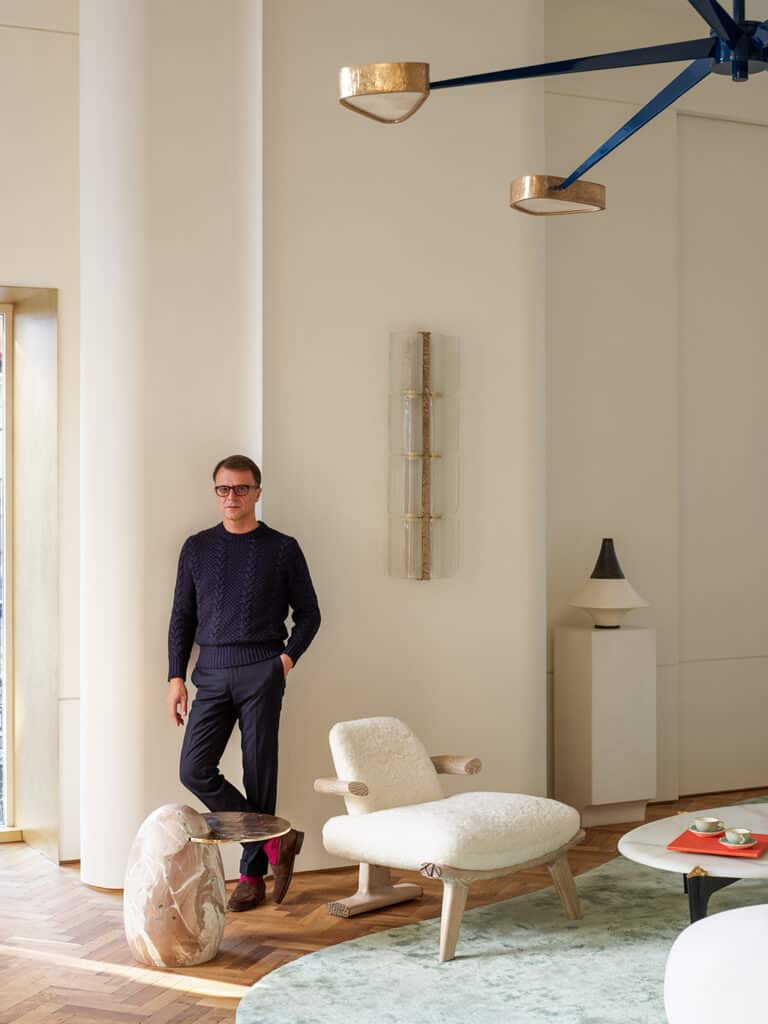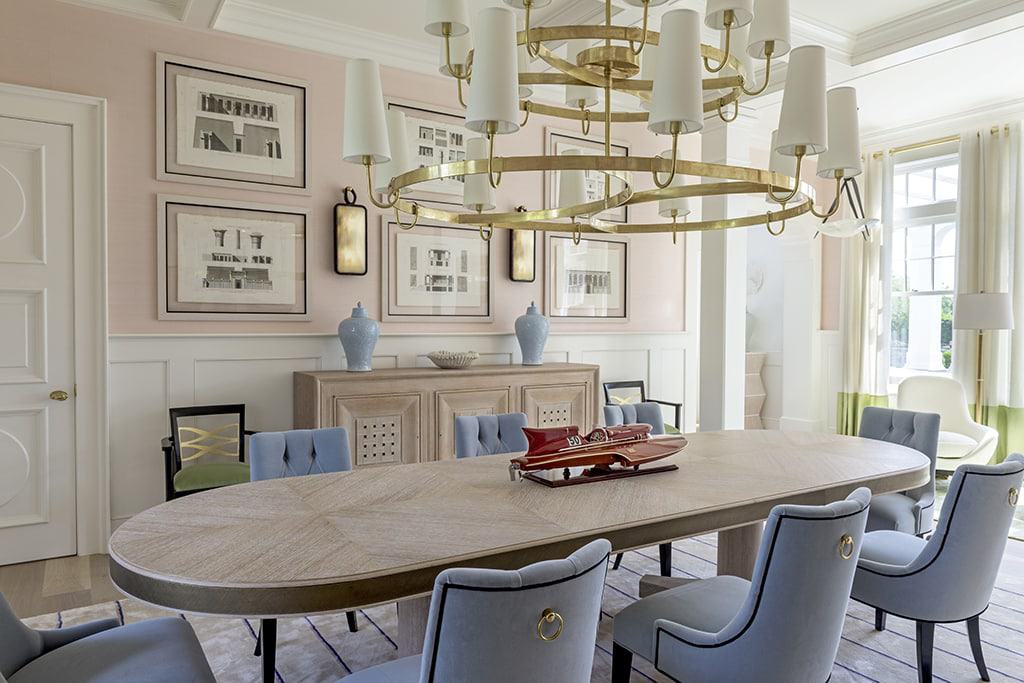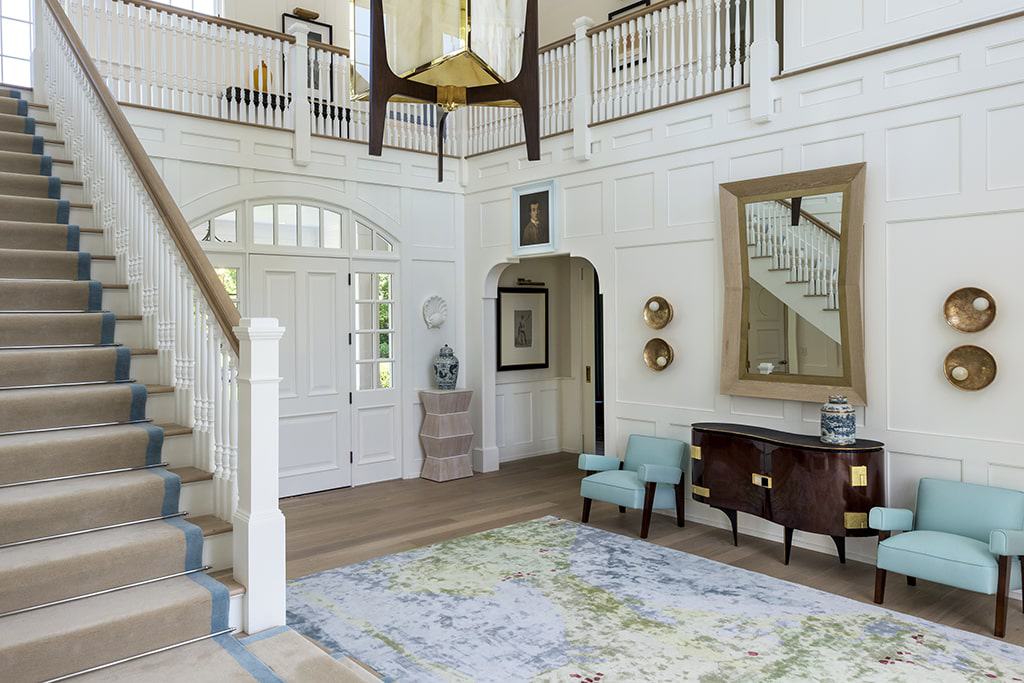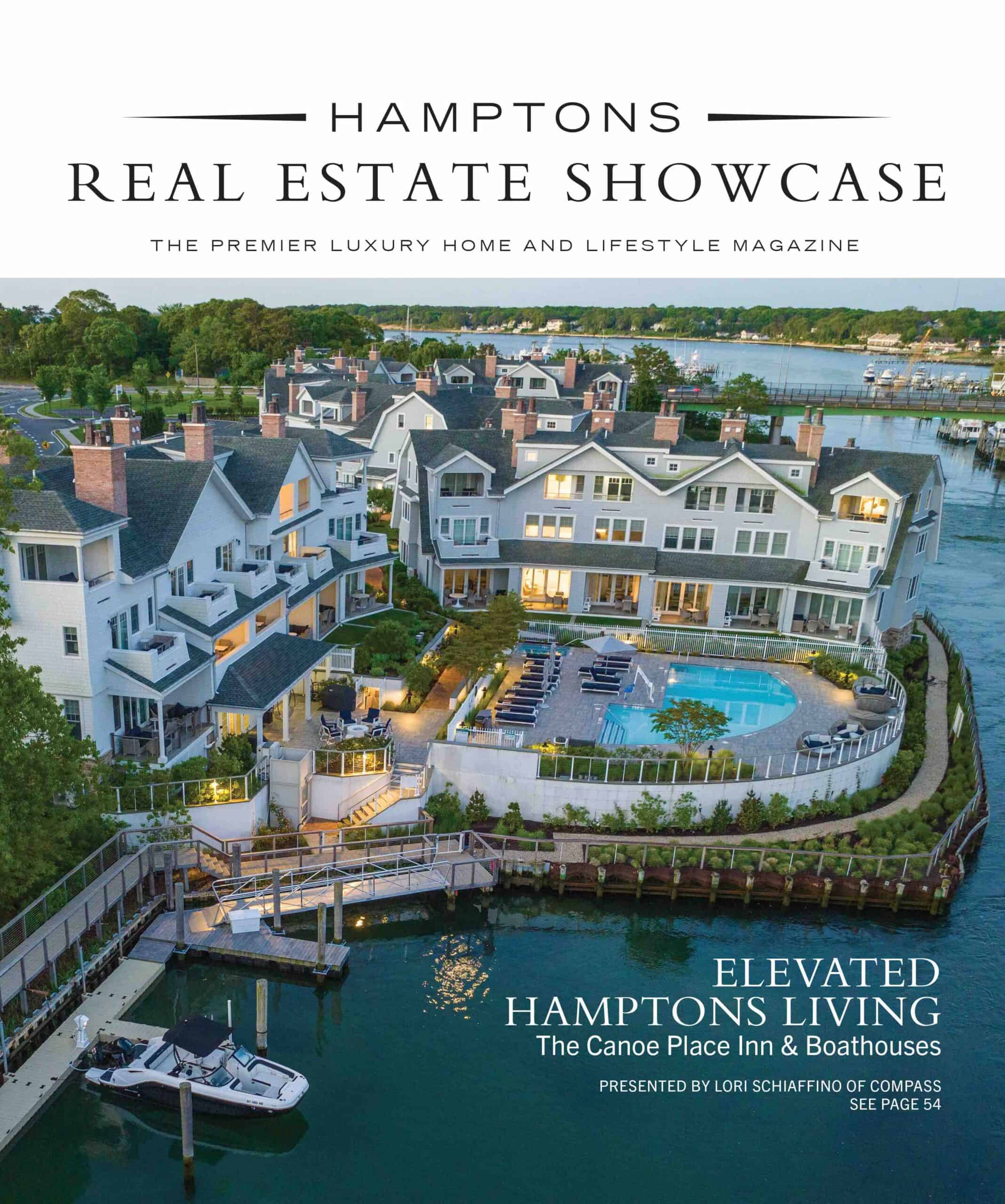The limited-edition furniture in Achille Salvagni’s new London gallery shares design DNA with a project in Southampton.
By Leila Jones
The Italian architect and designer Achille Salvagni, best known for his residential and yacht interiors and bespoke furniture, has moved his eponymous gallery in London’s Mayfair neighborhood to a big new space. With its great arched windows in bronze frames and round-cornered walls ‘wrapped’ in plaster, the venue’s design is every bit as bold as Salvagni’s exquisitely-detailed furniture and sumptuous homeware. At a time when we cannot predict what tomorrow — let alone the next six months — will bring, Salvagni is betting that eternal forms will carry the day.

The appeal is obvious. Current conditions have left of us hungering after design that is soft and textured. We want things of beauty that denote permanence, objects in curvilinear shapes and deep saturated hues. For some collectors and design-followers, Salvagni’s work, with its Italian baroque and Scandinavian modernist underpinnings, satisfies the aesthetic exigencies of our strange new reality.

“I am very much drawn to forms that evoke the sensuousness of a human body, a woman, a belly, to shapes that are organic rather than constructed,” says Salvagni, speaking from London. “Curves, rounded forms, the poetics of softness exemplified by the work of Alvar Alto and other Scandinavian architects and designers, is a means of engaging the natural world in a dialogue.”
But it’s the oneiric, richly allusive quality of his work that makes Salvagni unique. Consider his sensuously-curved ‘Hera’ cabinet. Covered in pomegranate-red parchment, the piece was inspired by the goddess of ancient myth with whom the fruit, a symbol of prosperity, is associated. Yet the pomegranate invariably brings to mind another myth, the one about an eternity of seasons in the underworld. From this perspective, the piece seems an objective correlative of the general mood.

The pandemic has been a gut punch to Italy, which has been harder hit by the pandemic than anywhere in Europe, and its government has made appeals to its neighbors to support both the country and the upholders of its cultural patrimony. Salvagni, who does astonishing things with sumptuous materials like twenty-four carat gold leaf, bronze, royal oak, and onyx, entrusts the execution of his designs to a select group of stone carvers, cabinetmakers, Murano glass-blowers, embroiderers (whose faces he has never seen for they are cloistered nuns), and a bronze caster who is held in high regard at the Vatican.
Given Salvagni’s distinctly European sensibility, you might be surprised to learn that in 2016 he designed the interiors of a quintessentially American compound on two acres in Southampton. The nine-bedroom, 14,000-square-foot mansion was built by Frances Fleetwood, whose ornate country houses are among the defining architectural structures of eastern Long Island.

Salvagni decided that the home’s interiors would evoke the glamour of the Amalfi Coast in the ‘50s and ‘60s, viewed through the double prism of the Hamptons and the designer’s sui generis aesthetic. (The Amalfi theme issued from the homeowner’s personal history.) The challenge was to do so in a way that complemented the interior architecture, which combined Gilded Age references and contemporary flourishes. In a feat of imagination, Salvagni designed furniture and sourced signed vintage pieces that seem at home somehow in the existing structure. His man who is in tight at the Vatican made fifty different bronze casts of the doorhandles in the shape of local fishes, birds, and seashells.

From the spidery bronze, onyx, and 24-carat-gold chandelier and the white rounded sofas in the living room to a sinuous cabinet in the entry hall, the pieces in the Southampton house share the same design DNA as the new works on view at the Mayfair gallery. If the second is the fullest expression of Salvagni’s talent, the first in hindsight was a thrilling preview of things to come.










![This stunning custom-built Dutch Colonial boasts soaring ceilings, breathtaking Intracoastal views, and seamless indoor-outdoor living. With an infinity pool, waterfront loggia, and top-tier finishes throughout, 2315 Ibis Isle Road S in Palm Beach is pure perfection. Represented by @angle_real_estate. [link in bio]](https://hamptonsrealestateshowcase.com/wp-content/uploads/sb-instagram-feed-images/484124060_18497198230030135_3943961196528713811_nfull.webp)

![This meticulously updated beach home boasts 4 bedrooms, 2 baths, lovely lake views, and sunset vistas from both living area and full length upper deck all on a .21± acre parcel. A 1,942± sq.ft. upside-down design, 93 Benson Drive comes fully furnished and has all you need for year-round enjoyment. Represented by @montaukbrokeratcorcoran of @thecorcorangroup. [link in bio]](https://hamptonsrealestateshowcase.com/wp-content/uploads/sb-instagram-feed-images/483238435_18496734973030135_6165376227797443768_nfull.webp)
![This stunning, designer-built, new construction set in the heart of Water Mill spans over 7,500± sq. ft. across three levels, featuring 7 bedrooms and 8.5 baths. 298 Montauk Highway offers a large gym with a sauna, private terraces, a custom theater room, and a luxurious gunite pool. Represented by @geoffgifkins of @nestseekers. [link in bio]](https://hamptonsrealestateshowcase.com/wp-content/uploads/sb-instagram-feed-images/483984839_18496528792030135_7028695074483476572_nfull.webp)
![Cheers to a new season! 🥃✨ @sagaponackfarmdistillery reopened yesterday, just in time for spring sips and scenic farm views. Stop by for a tasting and enjoy their locally crafted spirits made right here in the Hamptons! [link in bio]](https://hamptonsrealestateshowcase.com/wp-content/uploads/sb-instagram-feed-images/483138880_18496076707030135_7570935847890740582_nfull.webp)
![Closet, pantry, sock drawer, garage, basement. Are yours in good order? Now that we’re in a new year, it’s a perfect time to get organized and banish clutter. Here are some storage pieces that will help you store your joyful things beautifully. [link in bio]](https://hamptonsrealestateshowcase.com/wp-content/uploads/sb-instagram-feed-images/483035596_18495860242030135_2252271179951777966_nfull.webp)
![Exquisite Rottet Studio interiors boast expansive residences with floor-to-ceiling windows, gourmet Sub-Zero Wolf kitchens, and spa-inspired baths, all designed with meticulous precision. #RivageBalHarbour
Your sanctuary by the sea awaits. Visit RivageBalHarbour.com to learn more. [link in bio]](https://hamptonsrealestateshowcase.com/wp-content/uploads/sb-instagram-feed-images/483050961_18495662020030135_6140528890955064881_nfull.webp)
